BCME401 & GDCME801: Project Inception, Feasibility & Early Planning
VerifiedAdded on 2023/06/16
|17
|3960
|129
Essay
AI Summary
This essay explores the critical early design phases of project development, focusing on project inception, briefing, and early planning stages. It emphasizes factors like client needs, cost considerations, regulatory compliance, and construction expertise. The analysis uses the Salamander resort and Spa construction as a case study, highlighting the importance of stakeholder engagement, resource planning, and legislative requirements. Key objectives, such as designing a construction project that meets client requirements and avoids delays, are discussed. The essay also covers master planning, functional briefs, demographic considerations, and physical legislative requirements, underscoring the need for a comprehensive approach to project planning and execution. This document is available on Desklib, a platform providing study tools for students.
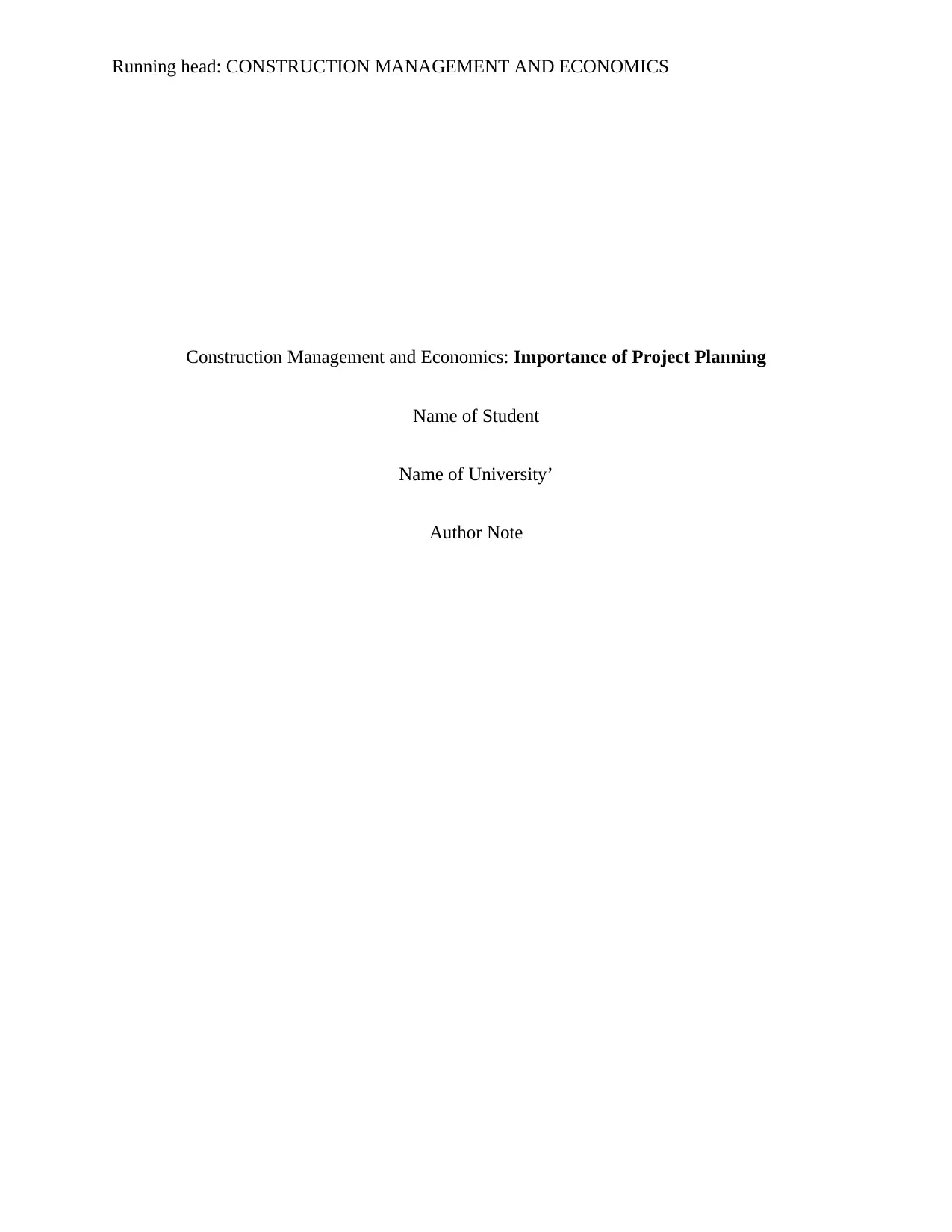
Running head: CONSTRUCTION MANAGEMENT AND ECONOMICS
Construction Management and Economics: Importance of Project Planning
Name of Student
Name of University’
Author Note
Construction Management and Economics: Importance of Project Planning
Name of Student
Name of University’
Author Note
Paraphrase This Document
Need a fresh take? Get an instant paraphrase of this document with our AI Paraphraser
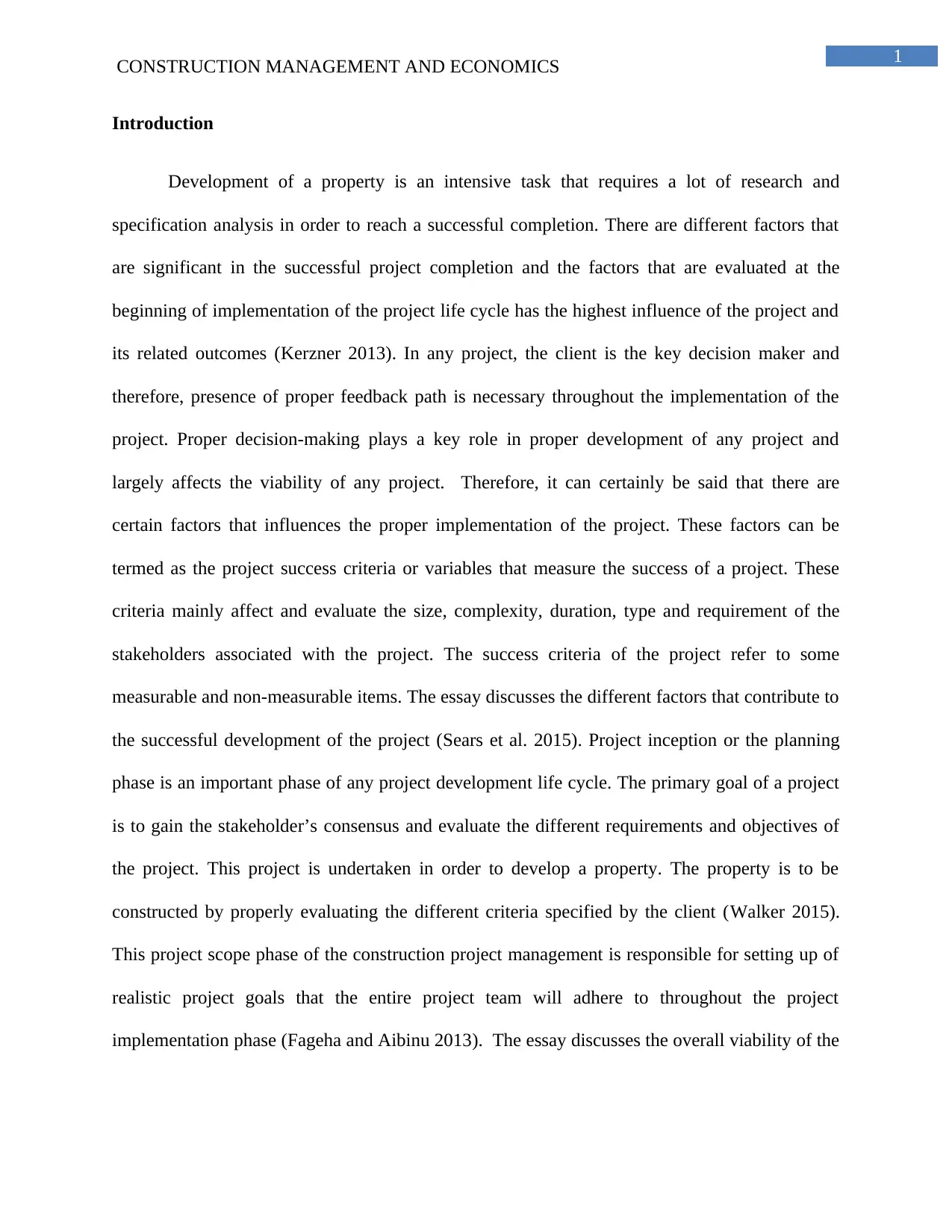
1
CONSTRUCTION MANAGEMENT AND ECONOMICS
Introduction
Development of a property is an intensive task that requires a lot of research and
specification analysis in order to reach a successful completion. There are different factors that
are significant in the successful project completion and the factors that are evaluated at the
beginning of implementation of the project life cycle has the highest influence of the project and
its related outcomes (Kerzner 2013). In any project, the client is the key decision maker and
therefore, presence of proper feedback path is necessary throughout the implementation of the
project. Proper decision-making plays a key role in proper development of any project and
largely affects the viability of any project. Therefore, it can certainly be said that there are
certain factors that influences the proper implementation of the project. These factors can be
termed as the project success criteria or variables that measure the success of a project. These
criteria mainly affect and evaluate the size, complexity, duration, type and requirement of the
stakeholders associated with the project. The success criteria of the project refer to some
measurable and non-measurable items. The essay discusses the different factors that contribute to
the successful development of the project (Sears et al. 2015). Project inception or the planning
phase is an important phase of any project development life cycle. The primary goal of a project
is to gain the stakeholder’s consensus and evaluate the different requirements and objectives of
the project. This project is undertaken in order to develop a property. The property is to be
constructed by properly evaluating the different criteria specified by the client (Walker 2015).
This project scope phase of the construction project management is responsible for setting up of
realistic project goals that the entire project team will adhere to throughout the project
implementation phase (Fageha and Aibinu 2013). The essay discusses the overall viability of the
CONSTRUCTION MANAGEMENT AND ECONOMICS
Introduction
Development of a property is an intensive task that requires a lot of research and
specification analysis in order to reach a successful completion. There are different factors that
are significant in the successful project completion and the factors that are evaluated at the
beginning of implementation of the project life cycle has the highest influence of the project and
its related outcomes (Kerzner 2013). In any project, the client is the key decision maker and
therefore, presence of proper feedback path is necessary throughout the implementation of the
project. Proper decision-making plays a key role in proper development of any project and
largely affects the viability of any project. Therefore, it can certainly be said that there are
certain factors that influences the proper implementation of the project. These factors can be
termed as the project success criteria or variables that measure the success of a project. These
criteria mainly affect and evaluate the size, complexity, duration, type and requirement of the
stakeholders associated with the project. The success criteria of the project refer to some
measurable and non-measurable items. The essay discusses the different factors that contribute to
the successful development of the project (Sears et al. 2015). Project inception or the planning
phase is an important phase of any project development life cycle. The primary goal of a project
is to gain the stakeholder’s consensus and evaluate the different requirements and objectives of
the project. This project is undertaken in order to develop a property. The property is to be
constructed by properly evaluating the different criteria specified by the client (Walker 2015).
This project scope phase of the construction project management is responsible for setting up of
realistic project goals that the entire project team will adhere to throughout the project
implementation phase (Fageha and Aibinu 2013). The essay discusses the overall viability of the
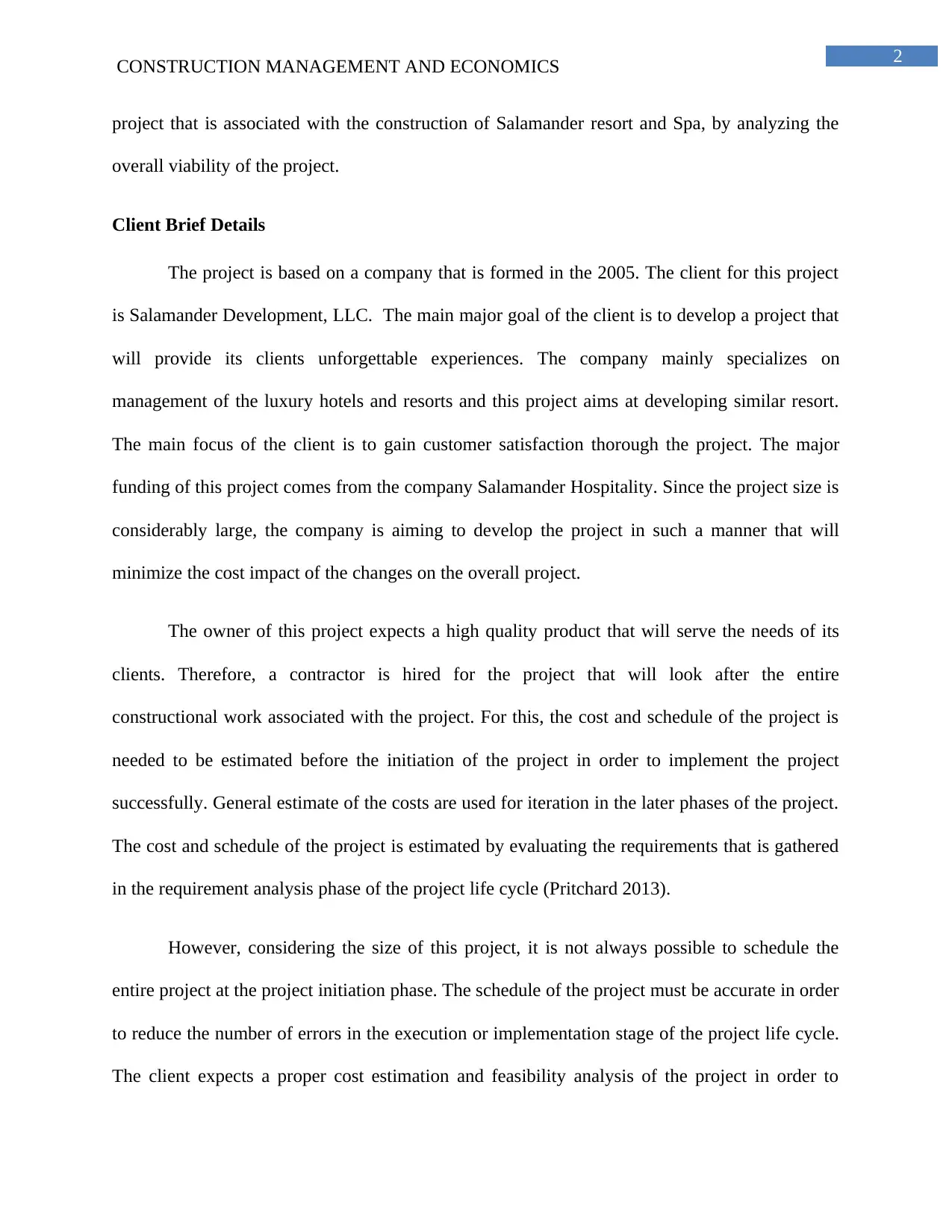
2
CONSTRUCTION MANAGEMENT AND ECONOMICS
project that is associated with the construction of Salamander resort and Spa, by analyzing the
overall viability of the project.
Client Brief Details
The project is based on a company that is formed in the 2005. The client for this project
is Salamander Development, LLC. The main major goal of the client is to develop a project that
will provide its clients unforgettable experiences. The company mainly specializes on
management of the luxury hotels and resorts and this project aims at developing similar resort.
The main focus of the client is to gain customer satisfaction thorough the project. The major
funding of this project comes from the company Salamander Hospitality. Since the project size is
considerably large, the company is aiming to develop the project in such a manner that will
minimize the cost impact of the changes on the overall project.
The owner of this project expects a high quality product that will serve the needs of its
clients. Therefore, a contractor is hired for the project that will look after the entire
constructional work associated with the project. For this, the cost and schedule of the project is
needed to be estimated before the initiation of the project in order to implement the project
successfully. General estimate of the costs are used for iteration in the later phases of the project.
The cost and schedule of the project is estimated by evaluating the requirements that is gathered
in the requirement analysis phase of the project life cycle (Pritchard 2013).
However, considering the size of this project, it is not always possible to schedule the
entire project at the project initiation phase. The schedule of the project must be accurate in order
to reduce the number of errors in the execution or implementation stage of the project life cycle.
The client expects a proper cost estimation and feasibility analysis of the project in order to
CONSTRUCTION MANAGEMENT AND ECONOMICS
project that is associated with the construction of Salamander resort and Spa, by analyzing the
overall viability of the project.
Client Brief Details
The project is based on a company that is formed in the 2005. The client for this project
is Salamander Development, LLC. The main major goal of the client is to develop a project that
will provide its clients unforgettable experiences. The company mainly specializes on
management of the luxury hotels and resorts and this project aims at developing similar resort.
The main focus of the client is to gain customer satisfaction thorough the project. The major
funding of this project comes from the company Salamander Hospitality. Since the project size is
considerably large, the company is aiming to develop the project in such a manner that will
minimize the cost impact of the changes on the overall project.
The owner of this project expects a high quality product that will serve the needs of its
clients. Therefore, a contractor is hired for the project that will look after the entire
constructional work associated with the project. For this, the cost and schedule of the project is
needed to be estimated before the initiation of the project in order to implement the project
successfully. General estimate of the costs are used for iteration in the later phases of the project.
The cost and schedule of the project is estimated by evaluating the requirements that is gathered
in the requirement analysis phase of the project life cycle (Pritchard 2013).
However, considering the size of this project, it is not always possible to schedule the
entire project at the project initiation phase. The schedule of the project must be accurate in order
to reduce the number of errors in the execution or implementation stage of the project life cycle.
The client expects a proper cost estimation and feasibility analysis of the project in order to
⊘ This is a preview!⊘
Do you want full access?
Subscribe today to unlock all pages.

Trusted by 1+ million students worldwide
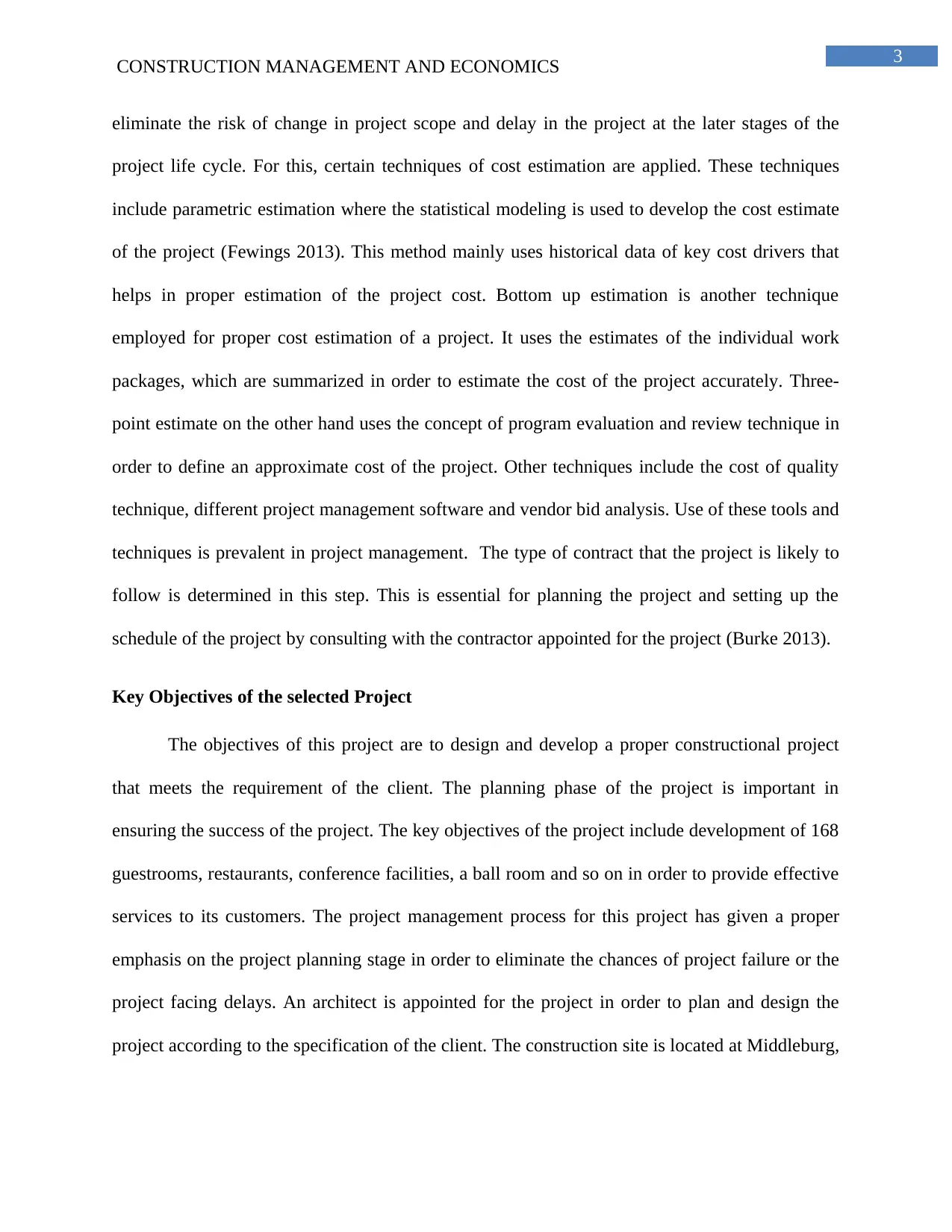
3
CONSTRUCTION MANAGEMENT AND ECONOMICS
eliminate the risk of change in project scope and delay in the project at the later stages of the
project life cycle. For this, certain techniques of cost estimation are applied. These techniques
include parametric estimation where the statistical modeling is used to develop the cost estimate
of the project (Fewings 2013). This method mainly uses historical data of key cost drivers that
helps in proper estimation of the project cost. Bottom up estimation is another technique
employed for proper cost estimation of a project. It uses the estimates of the individual work
packages, which are summarized in order to estimate the cost of the project accurately. Three-
point estimate on the other hand uses the concept of program evaluation and review technique in
order to define an approximate cost of the project. Other techniques include the cost of quality
technique, different project management software and vendor bid analysis. Use of these tools and
techniques is prevalent in project management. The type of contract that the project is likely to
follow is determined in this step. This is essential for planning the project and setting up the
schedule of the project by consulting with the contractor appointed for the project (Burke 2013).
Key Objectives of the selected Project
The objectives of this project are to design and develop a proper constructional project
that meets the requirement of the client. The planning phase of the project is important in
ensuring the success of the project. The key objectives of the project include development of 168
guestrooms, restaurants, conference facilities, a ball room and so on in order to provide effective
services to its customers. The project management process for this project has given a proper
emphasis on the project planning stage in order to eliminate the chances of project failure or the
project facing delays. An architect is appointed for the project in order to plan and design the
project according to the specification of the client. The construction site is located at Middleburg,
CONSTRUCTION MANAGEMENT AND ECONOMICS
eliminate the risk of change in project scope and delay in the project at the later stages of the
project life cycle. For this, certain techniques of cost estimation are applied. These techniques
include parametric estimation where the statistical modeling is used to develop the cost estimate
of the project (Fewings 2013). This method mainly uses historical data of key cost drivers that
helps in proper estimation of the project cost. Bottom up estimation is another technique
employed for proper cost estimation of a project. It uses the estimates of the individual work
packages, which are summarized in order to estimate the cost of the project accurately. Three-
point estimate on the other hand uses the concept of program evaluation and review technique in
order to define an approximate cost of the project. Other techniques include the cost of quality
technique, different project management software and vendor bid analysis. Use of these tools and
techniques is prevalent in project management. The type of contract that the project is likely to
follow is determined in this step. This is essential for planning the project and setting up the
schedule of the project by consulting with the contractor appointed for the project (Burke 2013).
Key Objectives of the selected Project
The objectives of this project are to design and develop a proper constructional project
that meets the requirement of the client. The planning phase of the project is important in
ensuring the success of the project. The key objectives of the project include development of 168
guestrooms, restaurants, conference facilities, a ball room and so on in order to provide effective
services to its customers. The project management process for this project has given a proper
emphasis on the project planning stage in order to eliminate the chances of project failure or the
project facing delays. An architect is appointed for the project in order to plan and design the
project according to the specification of the client. The construction site is located at Middleburg,
Paraphrase This Document
Need a fresh take? Get an instant paraphrase of this document with our AI Paraphraser
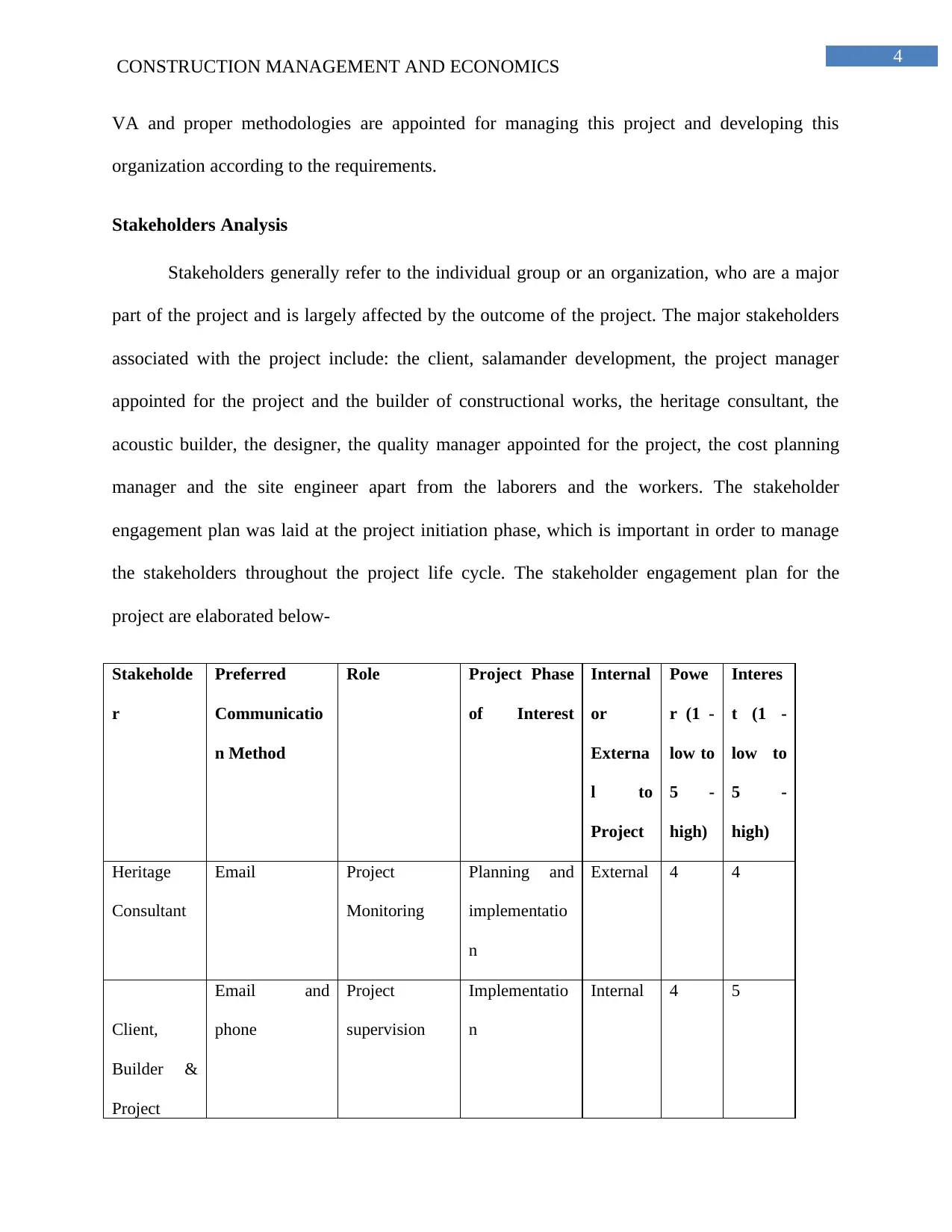
4
CONSTRUCTION MANAGEMENT AND ECONOMICS
VA and proper methodologies are appointed for managing this project and developing this
organization according to the requirements.
Stakeholders Analysis
Stakeholders generally refer to the individual group or an organization, who are a major
part of the project and is largely affected by the outcome of the project. The major stakeholders
associated with the project include: the client, salamander development, the project manager
appointed for the project and the builder of constructional works, the heritage consultant, the
acoustic builder, the designer, the quality manager appointed for the project, the cost planning
manager and the site engineer apart from the laborers and the workers. The stakeholder
engagement plan was laid at the project initiation phase, which is important in order to manage
the stakeholders throughout the project life cycle. The stakeholder engagement plan for the
project are elaborated below-
Stakeholde
r
Preferred
Communicatio
n Method
Role Project Phase
of Interest
Internal
or
Externa
l to
Project
Powe
r (1 -
low to
5 -
high)
Interes
t (1 -
low to
5 -
high)
Heritage
Consultant
Email Project
Monitoring
Planning and
implementatio
n
External 4 4
Client,
Builder &
Project
Email and
phone
Project
supervision
Implementatio
n
Internal 4 5
CONSTRUCTION MANAGEMENT AND ECONOMICS
VA and proper methodologies are appointed for managing this project and developing this
organization according to the requirements.
Stakeholders Analysis
Stakeholders generally refer to the individual group or an organization, who are a major
part of the project and is largely affected by the outcome of the project. The major stakeholders
associated with the project include: the client, salamander development, the project manager
appointed for the project and the builder of constructional works, the heritage consultant, the
acoustic builder, the designer, the quality manager appointed for the project, the cost planning
manager and the site engineer apart from the laborers and the workers. The stakeholder
engagement plan was laid at the project initiation phase, which is important in order to manage
the stakeholders throughout the project life cycle. The stakeholder engagement plan for the
project are elaborated below-
Stakeholde
r
Preferred
Communicatio
n Method
Role Project Phase
of Interest
Internal
or
Externa
l to
Project
Powe
r (1 -
low to
5 -
high)
Interes
t (1 -
low to
5 -
high)
Heritage
Consultant
Email Project
Monitoring
Planning and
implementatio
n
External 4 4
Client,
Builder &
Project
Email and
phone
Project
supervision
Implementatio
n
Internal 4 5
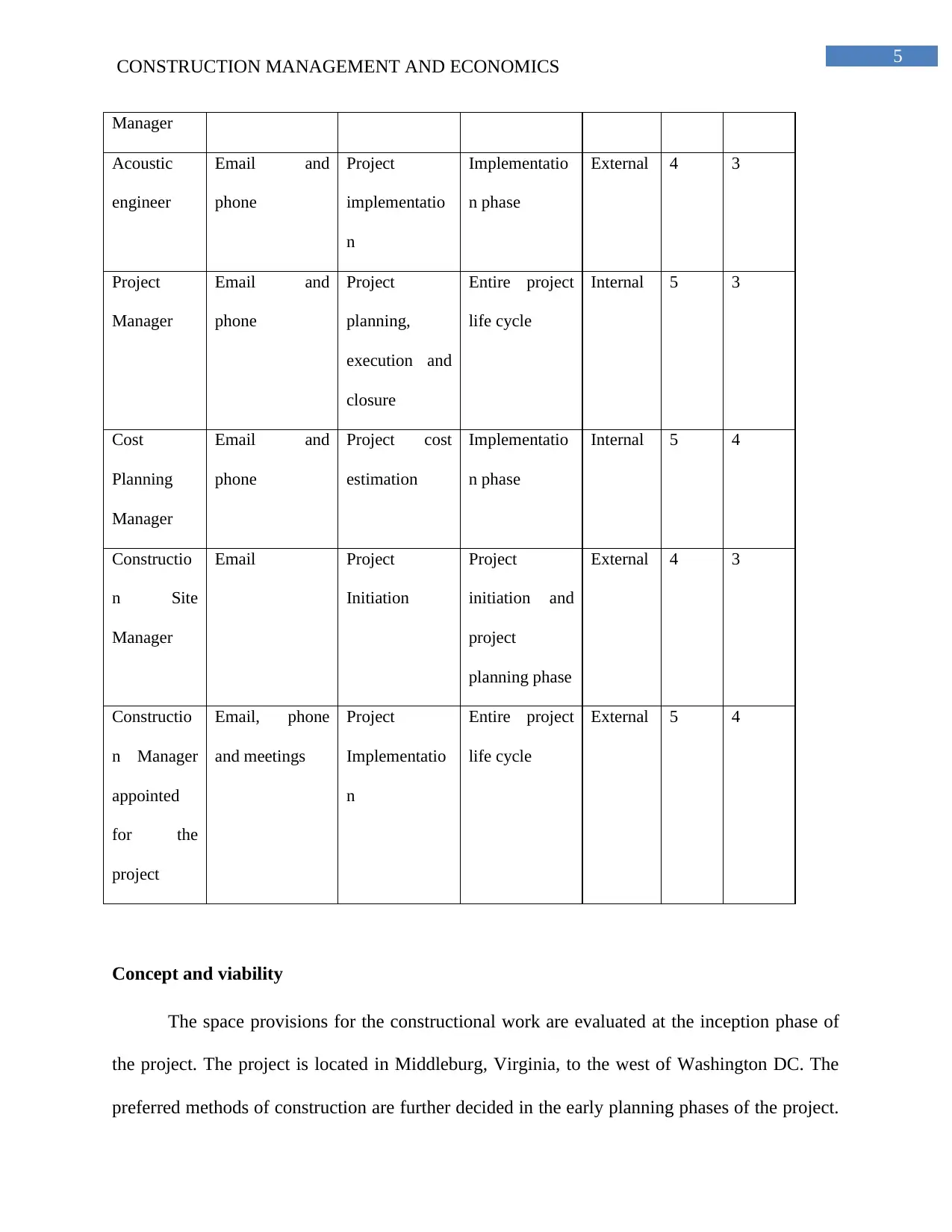
5
CONSTRUCTION MANAGEMENT AND ECONOMICS
Manager
Acoustic
engineer
Email and
phone
Project
implementatio
n
Implementatio
n phase
External 4 3
Project
Manager
Email and
phone
Project
planning,
execution and
closure
Entire project
life cycle
Internal 5 3
Cost
Planning
Manager
Email and
phone
Project cost
estimation
Implementatio
n phase
Internal 5 4
Constructio
n Site
Manager
Email Project
Initiation
Project
initiation and
project
planning phase
External 4 3
Constructio
n Manager
appointed
for the
project
Email, phone
and meetings
Project
Implementatio
n
Entire project
life cycle
External 5 4
Concept and viability
The space provisions for the constructional work are evaluated at the inception phase of
the project. The project is located in Middleburg, Virginia, to the west of Washington DC. The
preferred methods of construction are further decided in the early planning phases of the project.
CONSTRUCTION MANAGEMENT AND ECONOMICS
Manager
Acoustic
engineer
Email and
phone
Project
implementatio
n
Implementatio
n phase
External 4 3
Project
Manager
Email and
phone
Project
planning,
execution and
closure
Entire project
life cycle
Internal 5 3
Cost
Planning
Manager
Email and
phone
Project cost
estimation
Implementatio
n phase
Internal 5 4
Constructio
n Site
Manager
Email Project
Initiation
Project
initiation and
project
planning phase
External 4 3
Constructio
n Manager
appointed
for the
project
Email, phone
and meetings
Project
Implementatio
n
Entire project
life cycle
External 5 4
Concept and viability
The space provisions for the constructional work are evaluated at the inception phase of
the project. The project is located in Middleburg, Virginia, to the west of Washington DC. The
preferred methods of construction are further decided in the early planning phases of the project.
⊘ This is a preview!⊘
Do you want full access?
Subscribe today to unlock all pages.

Trusted by 1+ million students worldwide
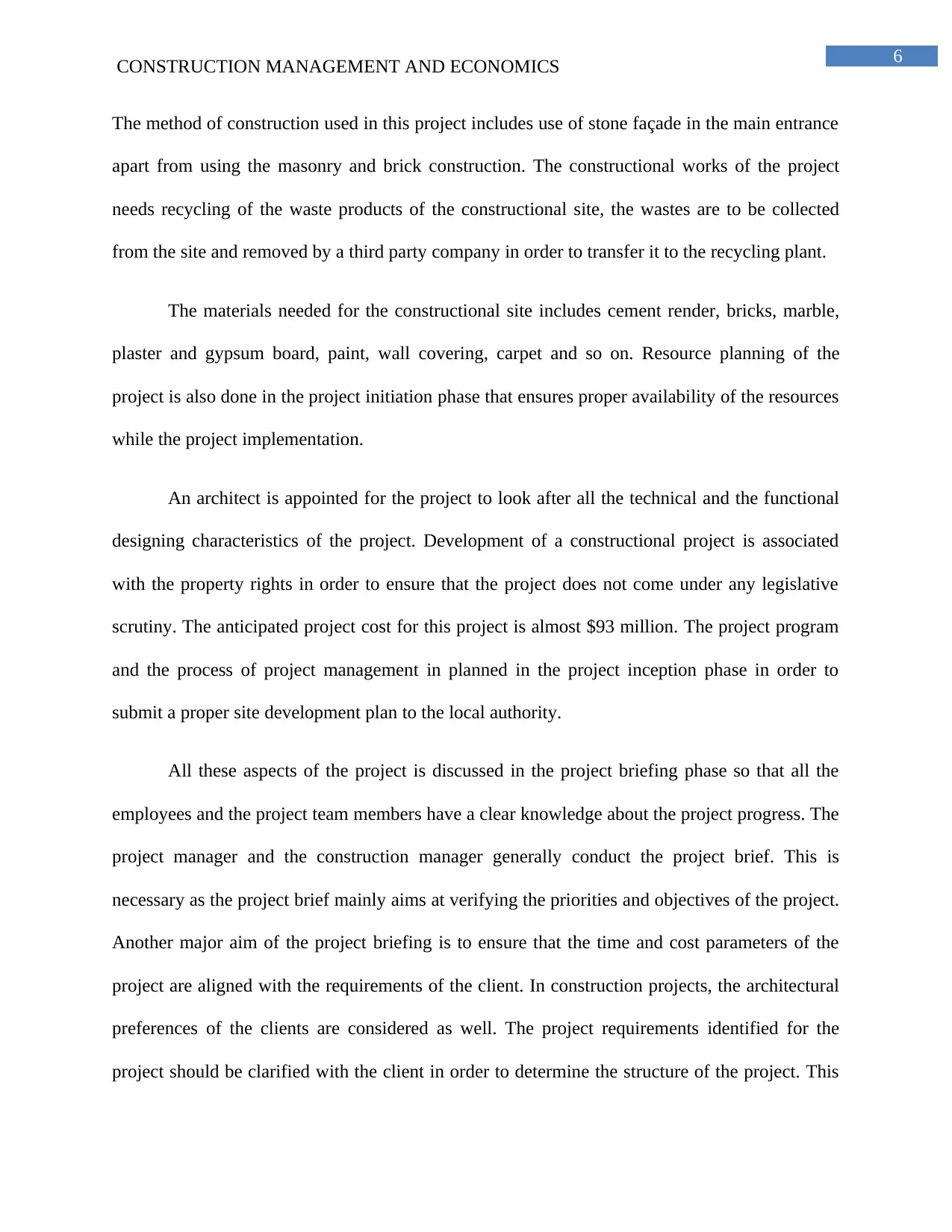
6
CONSTRUCTION MANAGEMENT AND ECONOMICS
The method of construction used in this project includes use of stone façade in the main entrance
apart from using the masonry and brick construction. The constructional works of the project
needs recycling of the waste products of the constructional site, the wastes are to be collected
from the site and removed by a third party company in order to transfer it to the recycling plant.
The materials needed for the constructional site includes cement render, bricks, marble,
plaster and gypsum board, paint, wall covering, carpet and so on. Resource planning of the
project is also done in the project initiation phase that ensures proper availability of the resources
while the project implementation.
An architect is appointed for the project to look after all the technical and the functional
designing characteristics of the project. Development of a constructional project is associated
with the property rights in order to ensure that the project does not come under any legislative
scrutiny. The anticipated project cost for this project is almost $93 million. The project program
and the process of project management in planned in the project inception phase in order to
submit a proper site development plan to the local authority.
All these aspects of the project is discussed in the project briefing phase so that all the
employees and the project team members have a clear knowledge about the project progress. The
project manager and the construction manager generally conduct the project brief. This is
necessary as the project brief mainly aims at verifying the priorities and objectives of the project.
Another major aim of the project briefing is to ensure that the time and cost parameters of the
project are aligned with the requirements of the client. In construction projects, the architectural
preferences of the clients are considered as well. The project requirements identified for the
project should be clarified with the client in order to determine the structure of the project. This
CONSTRUCTION MANAGEMENT AND ECONOMICS
The method of construction used in this project includes use of stone façade in the main entrance
apart from using the masonry and brick construction. The constructional works of the project
needs recycling of the waste products of the constructional site, the wastes are to be collected
from the site and removed by a third party company in order to transfer it to the recycling plant.
The materials needed for the constructional site includes cement render, bricks, marble,
plaster and gypsum board, paint, wall covering, carpet and so on. Resource planning of the
project is also done in the project initiation phase that ensures proper availability of the resources
while the project implementation.
An architect is appointed for the project to look after all the technical and the functional
designing characteristics of the project. Development of a constructional project is associated
with the property rights in order to ensure that the project does not come under any legislative
scrutiny. The anticipated project cost for this project is almost $93 million. The project program
and the process of project management in planned in the project inception phase in order to
submit a proper site development plan to the local authority.
All these aspects of the project is discussed in the project briefing phase so that all the
employees and the project team members have a clear knowledge about the project progress. The
project manager and the construction manager generally conduct the project brief. This is
necessary as the project brief mainly aims at verifying the priorities and objectives of the project.
Another major aim of the project briefing is to ensure that the time and cost parameters of the
project are aligned with the requirements of the client. In construction projects, the architectural
preferences of the clients are considered as well. The project requirements identified for the
project should be clarified with the client in order to determine the structure of the project. This
Paraphrase This Document
Need a fresh take? Get an instant paraphrase of this document with our AI Paraphraser
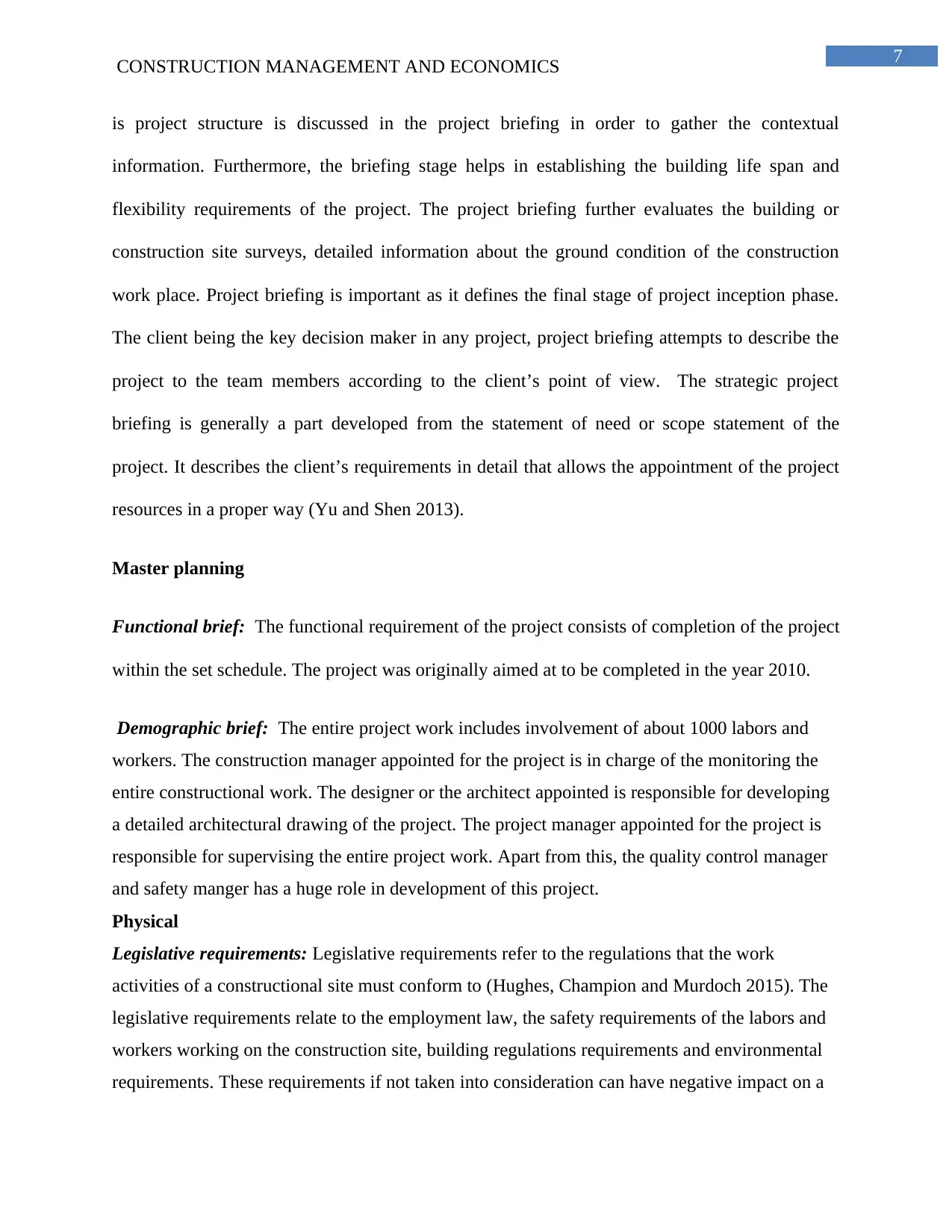
7
CONSTRUCTION MANAGEMENT AND ECONOMICS
is project structure is discussed in the project briefing in order to gather the contextual
information. Furthermore, the briefing stage helps in establishing the building life span and
flexibility requirements of the project. The project briefing further evaluates the building or
construction site surveys, detailed information about the ground condition of the construction
work place. Project briefing is important as it defines the final stage of project inception phase.
The client being the key decision maker in any project, project briefing attempts to describe the
project to the team members according to the client’s point of view. The strategic project
briefing is generally a part developed from the statement of need or scope statement of the
project. It describes the client’s requirements in detail that allows the appointment of the project
resources in a proper way (Yu and Shen 2013).
Master planning
Functional brief: The functional requirement of the project consists of completion of the project
within the set schedule. The project was originally aimed at to be completed in the year 2010.
Demographic brief: The entire project work includes involvement of about 1000 labors and
workers. The construction manager appointed for the project is in charge of the monitoring the
entire constructional work. The designer or the architect appointed is responsible for developing
a detailed architectural drawing of the project. The project manager appointed for the project is
responsible for supervising the entire project work. Apart from this, the quality control manager
and safety manger has a huge role in development of this project.
Physical
Legislative requirements: Legislative requirements refer to the regulations that the work
activities of a constructional site must conform to (Hughes, Champion and Murdoch 2015). The
legislative requirements relate to the employment law, the safety requirements of the labors and
workers working on the construction site, building regulations requirements and environmental
requirements. These requirements if not taken into consideration can have negative impact on a
CONSTRUCTION MANAGEMENT AND ECONOMICS
is project structure is discussed in the project briefing in order to gather the contextual
information. Furthermore, the briefing stage helps in establishing the building life span and
flexibility requirements of the project. The project briefing further evaluates the building or
construction site surveys, detailed information about the ground condition of the construction
work place. Project briefing is important as it defines the final stage of project inception phase.
The client being the key decision maker in any project, project briefing attempts to describe the
project to the team members according to the client’s point of view. The strategic project
briefing is generally a part developed from the statement of need or scope statement of the
project. It describes the client’s requirements in detail that allows the appointment of the project
resources in a proper way (Yu and Shen 2013).
Master planning
Functional brief: The functional requirement of the project consists of completion of the project
within the set schedule. The project was originally aimed at to be completed in the year 2010.
Demographic brief: The entire project work includes involvement of about 1000 labors and
workers. The construction manager appointed for the project is in charge of the monitoring the
entire constructional work. The designer or the architect appointed is responsible for developing
a detailed architectural drawing of the project. The project manager appointed for the project is
responsible for supervising the entire project work. Apart from this, the quality control manager
and safety manger has a huge role in development of this project.
Physical
Legislative requirements: Legislative requirements refer to the regulations that the work
activities of a constructional site must conform to (Hughes, Champion and Murdoch 2015). The
legislative requirements relate to the employment law, the safety requirements of the labors and
workers working on the construction site, building regulations requirements and environmental
requirements. These requirements if not taken into consideration can have negative impact on a
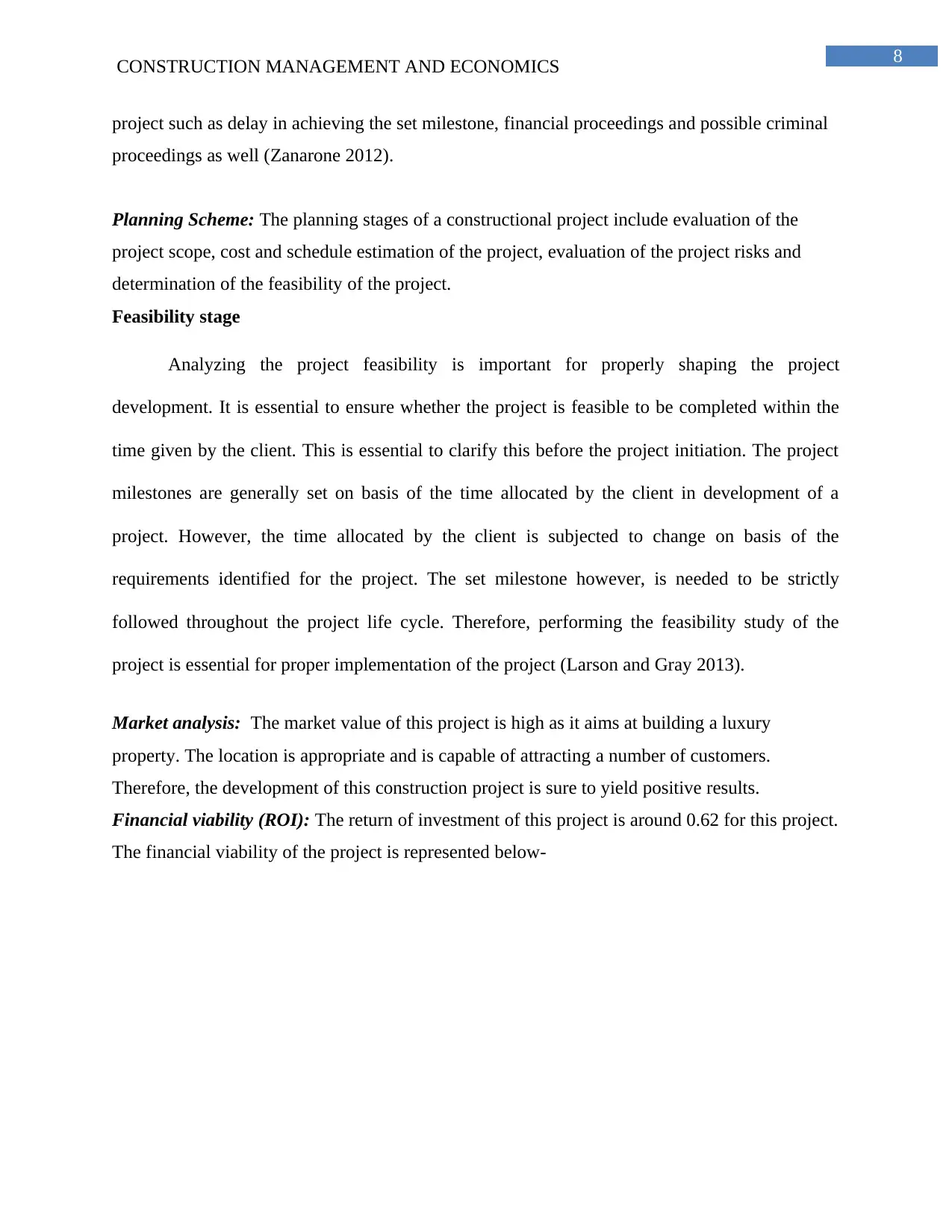
8
CONSTRUCTION MANAGEMENT AND ECONOMICS
project such as delay in achieving the set milestone, financial proceedings and possible criminal
proceedings as well (Zanarone 2012).
Planning Scheme: The planning stages of a constructional project include evaluation of the
project scope, cost and schedule estimation of the project, evaluation of the project risks and
determination of the feasibility of the project.
Feasibility stage
Analyzing the project feasibility is important for properly shaping the project
development. It is essential to ensure whether the project is feasible to be completed within the
time given by the client. This is essential to clarify this before the project initiation. The project
milestones are generally set on basis of the time allocated by the client in development of a
project. However, the time allocated by the client is subjected to change on basis of the
requirements identified for the project. The set milestone however, is needed to be strictly
followed throughout the project life cycle. Therefore, performing the feasibility study of the
project is essential for proper implementation of the project (Larson and Gray 2013).
Market analysis: The market value of this project is high as it aims at building a luxury
property. The location is appropriate and is capable of attracting a number of customers.
Therefore, the development of this construction project is sure to yield positive results.
Financial viability (ROI): The return of investment of this project is around 0.62 for this project.
The financial viability of the project is represented below-
CONSTRUCTION MANAGEMENT AND ECONOMICS
project such as delay in achieving the set milestone, financial proceedings and possible criminal
proceedings as well (Zanarone 2012).
Planning Scheme: The planning stages of a constructional project include evaluation of the
project scope, cost and schedule estimation of the project, evaluation of the project risks and
determination of the feasibility of the project.
Feasibility stage
Analyzing the project feasibility is important for properly shaping the project
development. It is essential to ensure whether the project is feasible to be completed within the
time given by the client. This is essential to clarify this before the project initiation. The project
milestones are generally set on basis of the time allocated by the client in development of a
project. However, the time allocated by the client is subjected to change on basis of the
requirements identified for the project. The set milestone however, is needed to be strictly
followed throughout the project life cycle. Therefore, performing the feasibility study of the
project is essential for proper implementation of the project (Larson and Gray 2013).
Market analysis: The market value of this project is high as it aims at building a luxury
property. The location is appropriate and is capable of attracting a number of customers.
Therefore, the development of this construction project is sure to yield positive results.
Financial viability (ROI): The return of investment of this project is around 0.62 for this project.
The financial viability of the project is represented below-
⊘ This is a preview!⊘
Do you want full access?
Subscribe today to unlock all pages.

Trusted by 1+ million students worldwide
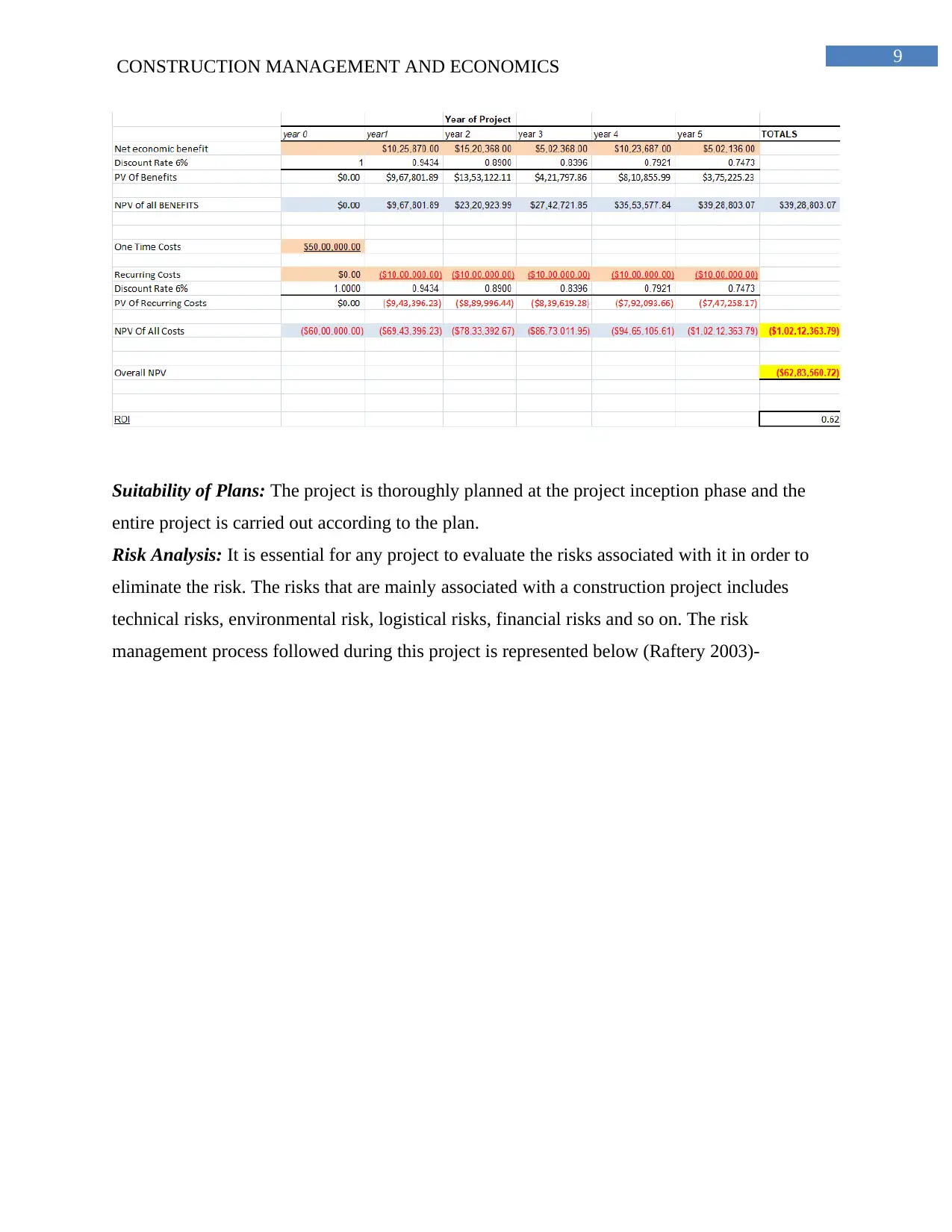
9
CONSTRUCTION MANAGEMENT AND ECONOMICS
Suitability of Plans: The project is thoroughly planned at the project inception phase and the
entire project is carried out according to the plan.
Risk Analysis: It is essential for any project to evaluate the risks associated with it in order to
eliminate the risk. The risks that are mainly associated with a construction project includes
technical risks, environmental risk, logistical risks, financial risks and so on. The risk
management process followed during this project is represented below (Raftery 2003)-
CONSTRUCTION MANAGEMENT AND ECONOMICS
Suitability of Plans: The project is thoroughly planned at the project inception phase and the
entire project is carried out according to the plan.
Risk Analysis: It is essential for any project to evaluate the risks associated with it in order to
eliminate the risk. The risks that are mainly associated with a construction project includes
technical risks, environmental risk, logistical risks, financial risks and so on. The risk
management process followed during this project is represented below (Raftery 2003)-
Paraphrase This Document
Need a fresh take? Get an instant paraphrase of this document with our AI Paraphraser
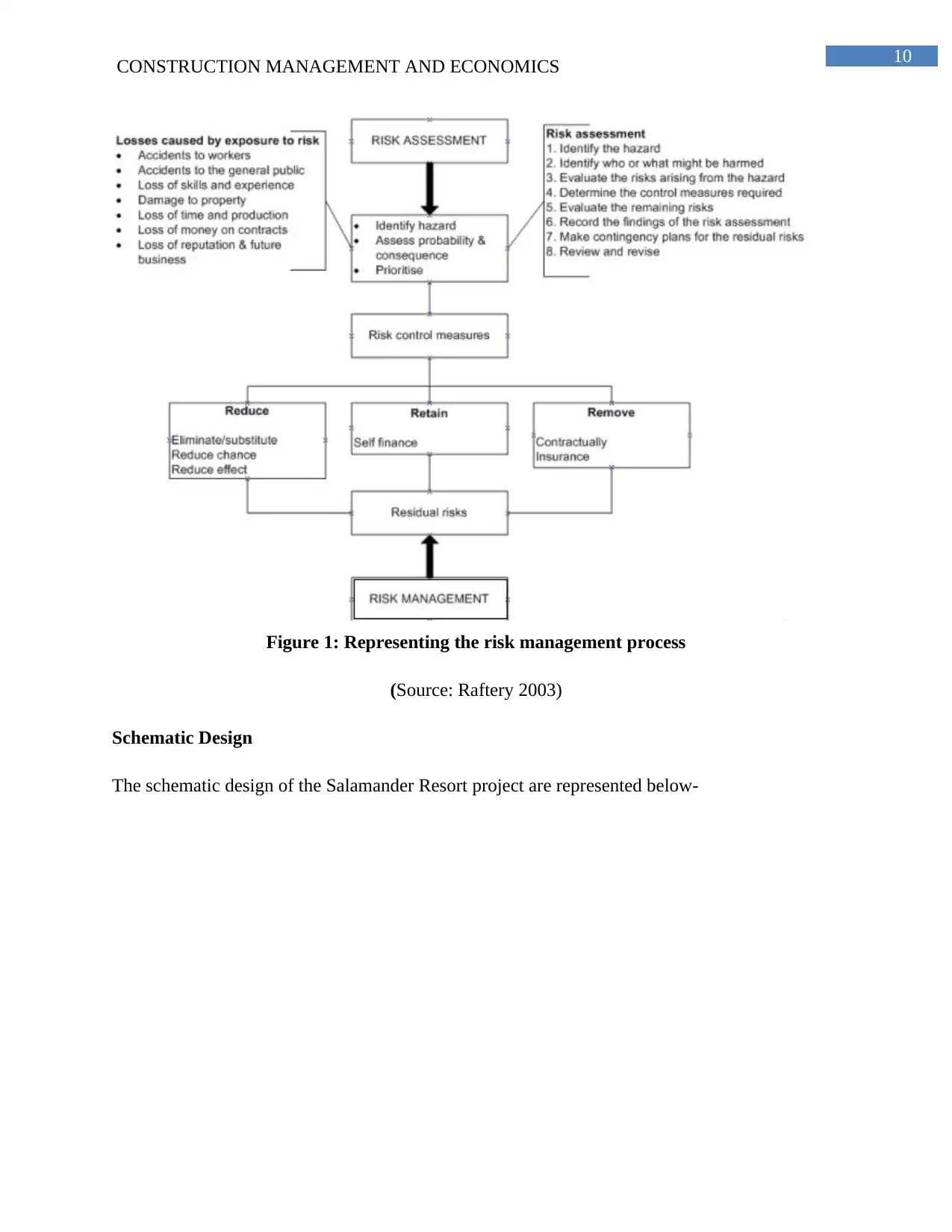
10
CONSTRUCTION MANAGEMENT AND ECONOMICS
Figure 1: Representing the risk management process
(Source: Raftery 2003)
Schematic Design
The schematic design of the Salamander Resort project are represented below-
CONSTRUCTION MANAGEMENT AND ECONOMICS
Figure 1: Representing the risk management process
(Source: Raftery 2003)
Schematic Design
The schematic design of the Salamander Resort project are represented below-
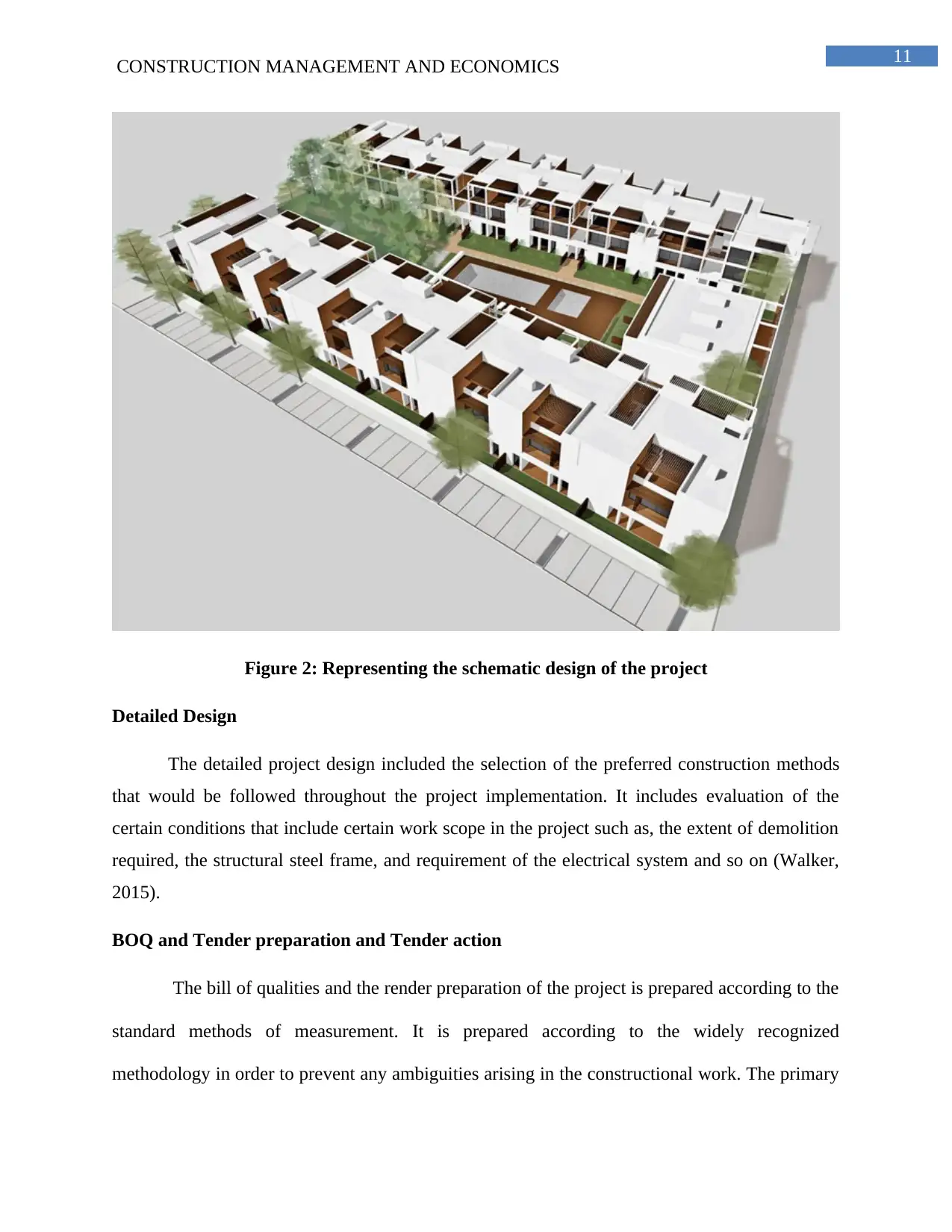
11
CONSTRUCTION MANAGEMENT AND ECONOMICS
Figure 2: Representing the schematic design of the project
Detailed Design
The detailed project design included the selection of the preferred construction methods
that would be followed throughout the project implementation. It includes evaluation of the
certain conditions that include certain work scope in the project such as, the extent of demolition
required, the structural steel frame, and requirement of the electrical system and so on (Walker,
2015).
BOQ and Tender preparation and Tender action
The bill of qualities and the render preparation of the project is prepared according to the
standard methods of measurement. It is prepared according to the widely recognized
methodology in order to prevent any ambiguities arising in the constructional work. The primary
CONSTRUCTION MANAGEMENT AND ECONOMICS
Figure 2: Representing the schematic design of the project
Detailed Design
The detailed project design included the selection of the preferred construction methods
that would be followed throughout the project implementation. It includes evaluation of the
certain conditions that include certain work scope in the project such as, the extent of demolition
required, the structural steel frame, and requirement of the electrical system and so on (Walker,
2015).
BOQ and Tender preparation and Tender action
The bill of qualities and the render preparation of the project is prepared according to the
standard methods of measurement. It is prepared according to the widely recognized
methodology in order to prevent any ambiguities arising in the constructional work. The primary
⊘ This is a preview!⊘
Do you want full access?
Subscribe today to unlock all pages.

Trusted by 1+ million students worldwide
1 out of 17
Related Documents
Your All-in-One AI-Powered Toolkit for Academic Success.
+13062052269
info@desklib.com
Available 24*7 on WhatsApp / Email
![[object Object]](/_next/static/media/star-bottom.7253800d.svg)
Unlock your academic potential
Copyright © 2020–2025 A2Z Services. All Rights Reserved. Developed and managed by ZUCOL.





